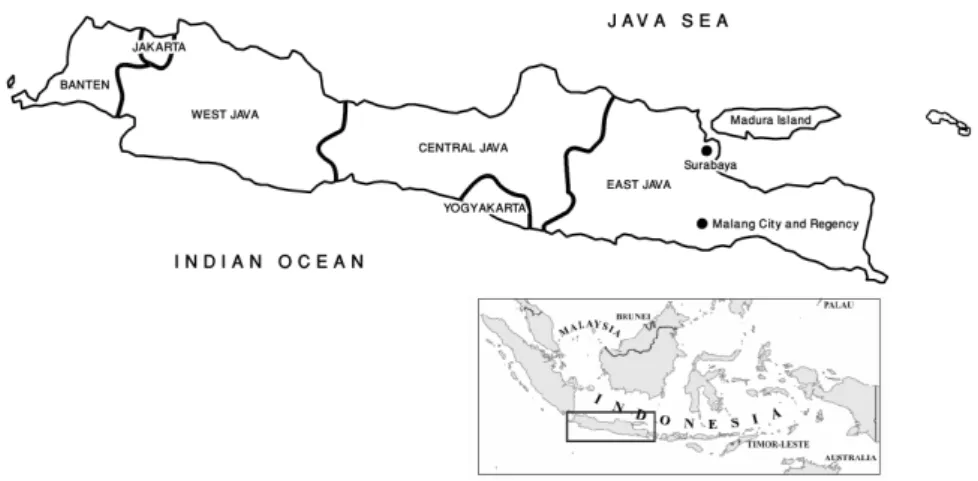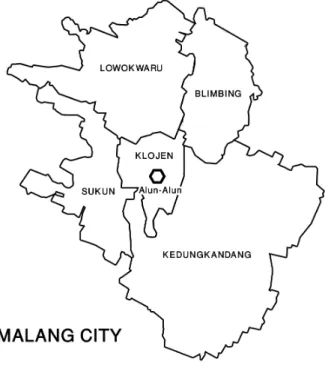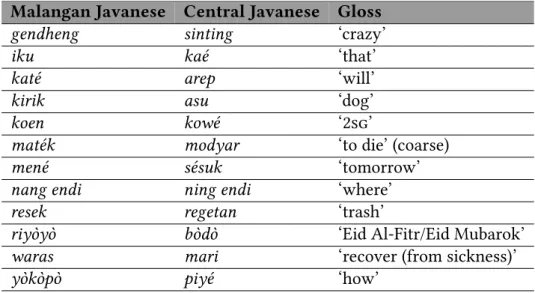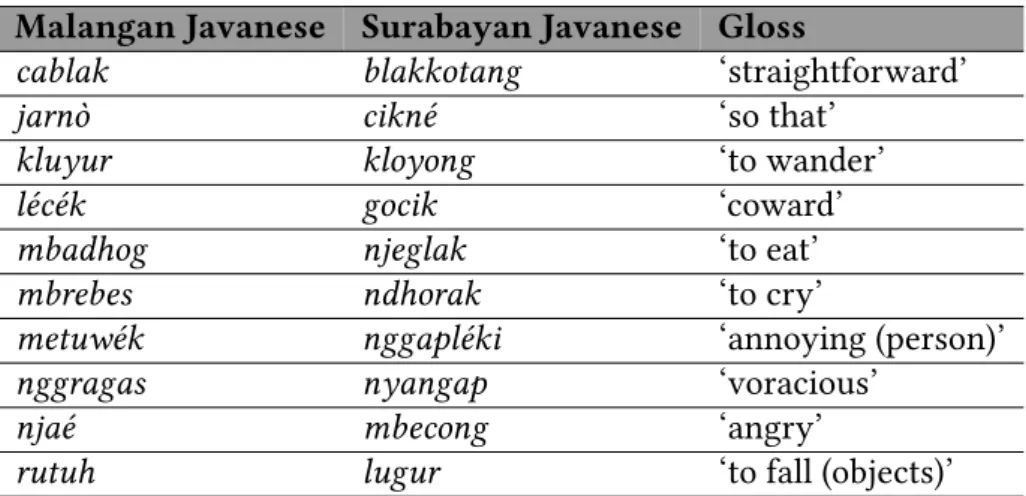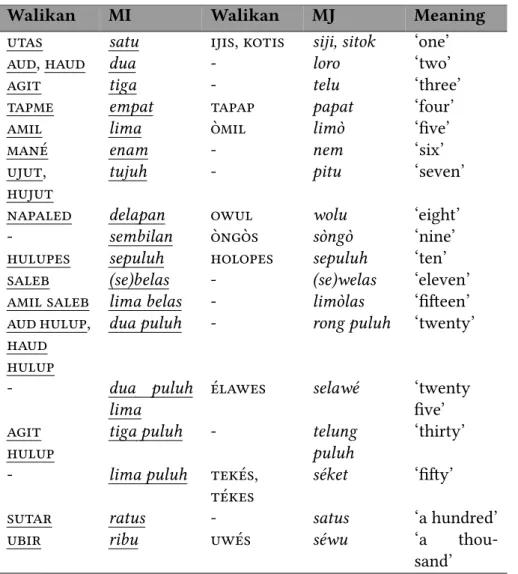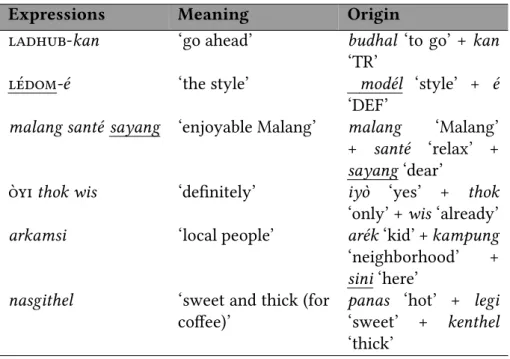Sophie, thanks for all the discussions we had about Javanese, and also for the nice Dutch summary. And to Tyas and family, thank you for all the help during my stay in the Netherlands.
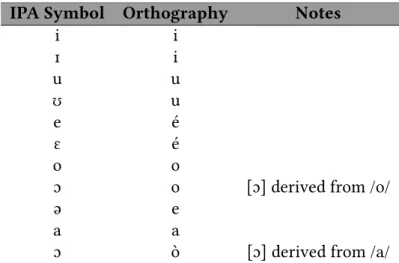
Malang
Geographical Setting
The area of Malang city is divided into five districts (kecamatan) that manage a total of 57 administrative villages (kelurahan). The wider Malang regency is divided into 33 districts and includes more than 60 administrative villages (Sekilas Malang 2017; Selayang Pandang 2017).
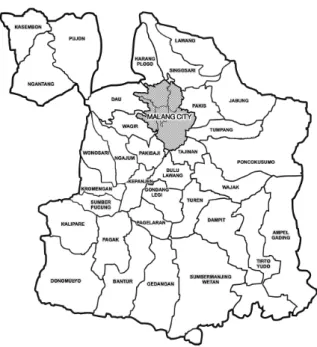
History of Malang
Social Setting
Linguistic Background
Malangan Javanese
Ti Walikan ket mangibagbaga ti panagusar kadagiti baliktad a Malangan a Javanese ken Malangan nga Indonesiano a balikas, nga adda ti Malangan a Javanese a kas ti matrix a pagsasao. Ti isu met laeng a kasasaad ket mabalin a makita idiay Malang, a sadiay ti Ngoko Malangan a Javanese ket naus-usar a kas ti pagsasao ti matrix para iti Walikan.

Malangan Indonesian
Malangan Indonesian is often preferred to Javanese by younger speakers when addressing an older person. The combination of both Malangan Javanese and Malangan Indonesian in the speech of the same person is often heard.
Previous Studies
It compares Walikan to another East Javanese youth language spoken in the neighboring city of Surabaya. Words not found in my own database but confirmed by my informants have been added to the final list of 725 Walikan words (see Appendix B).
The Present Study
Methodology and Data Collection
Most of the informants were born in Malang and lived in the city at the time of the study, although a number of them originated from or currently live in the regency of Malang. The title of the project was Kajian Linguistik Bahasa Walikan Malangan'The Linguistic Study of Bahasa Walikan Malangan'.
The Corpus
- Spoken Data of Walikan
- Written Data of Walikan
- Data of Malangan Javanese and
- Data Archiving
Walikan's digital stickers were collected directly from an informant who was the creator of the stickers. Additionally, I took pictures of Walikan words used in Malang's public spaces while riding around the city as a motorcycle passenger.

Organization of the Study
To systematically examine Walikan's complexity, this chapter links Walikan forms to his practice using Silverstein's (1985) Total Linguistic Fact (TLF). To quote Silverstein (1985): “The total linguistic fact, the given for a linguistic science, is irreducibly dialectical in nature.
On Youth Languages
In this light, some youth languages constitute an "anti-language" (Halliday 1976), a form of language created by and belonging to a stigmatized community, including criminals, thugs, prostitutes, and ethnic minorities (Kießling and Mous). 2004). The word 'youth' is essential to indicate the age of speakers who typically introduce youth languages (Djenar 2015; Mous 2009).
Forms of Walikan
Phonological Manipulation
- Local Variations
The first type of sequence exchange allows a reversal of only the first CVC sequence of the word (7). In (12), bécakis is a Malananese Javanese word, while kacéb is the reverse form of the former.
Semantic Manipulation
The literal meaning of the phrase is 'to lean against the wall', but not for older speakers. However, today the term generally means 'to relax' or 'to relax' for younger speakers.
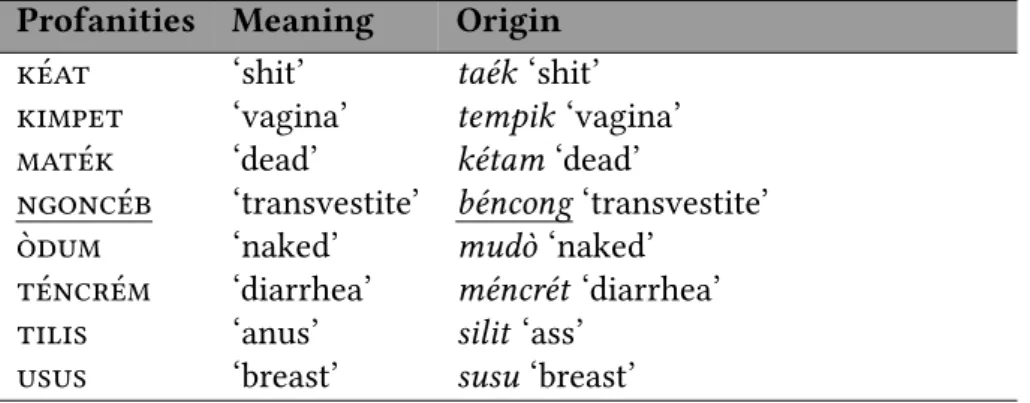
The Changing Face of Walikan
The story of Major Hamid Roesdi is deeply rooted in the heart of the people and he is generally praised as an important figure behind the creation of Walikan. The use of Walikan set them apart from other groups at school because Walikan was perceived as the cool way to speak.
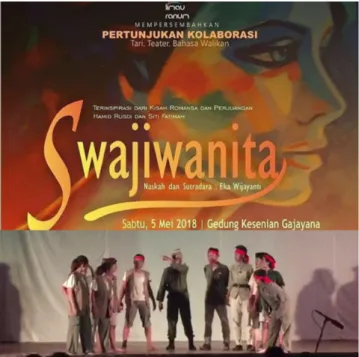
Today’s Use of Walikan: Projecting a Shared Identity . 57
It seemed to them that the reversed speech is the most prominent identity marker of the people of Malang, so they decided to write the song in Walikan. The notion of meaning in Walikan is constructed through its manipulated forms of language: inverted words.
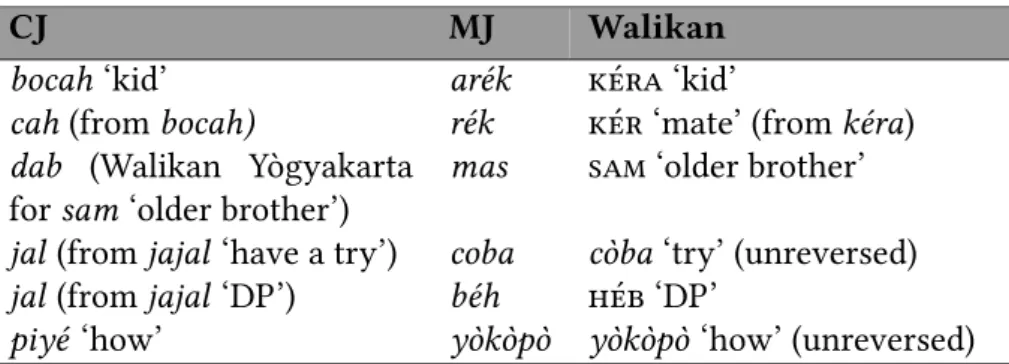
Conclusions
A closer look at the semantics of Walikan can provide insight into the dynamic and rapidly changing nature of society, as evidenced by the changing meanings of a handful of words and phrases, such as néndhés kombét 'to calm down' from 'to take the drug'. and from the existence of words describing the past social situation, such as idrek 'to work', originating from the colonial-flavored termkerdi, (kerja rodi) 'corvée labor'. Furthermore, apart from certain lexicalized expressions, such as anamid 'where', participles and possessive pronouns are not part of the reflexive, instead they are attached to a reverse root.
Malangan Javanese
Segment Inventory of Malangan Javanese
Contrary to what the spelling suggests, the Malangan Javanese places do not differ in voice. Malangan Javanese also has a glottal stop [ʔ], but here this consonant is analyzed as non-phonemic.
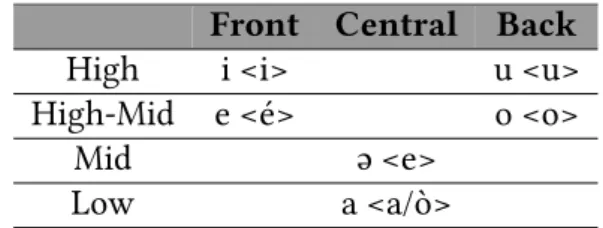
Description of the Consonants
- The Stops
- The Nasals
- The Fricatives
- The Trill and the Lateral
- The Approximants
The glottal stop [ʔ] in Malangan Javanese occurs as a result of competing processes, as shown in (12 - 19). Finally, the glottal stop [ʔ] occurs between two identical vowels in loanwords (18) and word medially between consonants in loanwords (19).
Description of the Vowels
- The High Vowels
- The High-Mid Vowels
- The Mid Vowel
- The Low Vowel
- Loan Consonants
Further, the front high mid vowel /e/ is realized as [ɛ] in an open syllable when the following open syllable has a high vowel or an [ɔ] which is basically a low central vowel / a/ (42) . The high mid back vowel /o/ is also realized as [ɔ] in an open syllable when the following open syllable contains a high vowel or a low vowel (43).
Phonotactics
- Consonants
- Vowels
The high vowels /i/ and /u/ are realized as [ɪ] and [ʊ], respectively, in a penultimate open syllable before a closed syllable containing a high vowel. The low central vowel /a/ is realized as [ɔ] in a penultimate open syllable before an open syllable that has a low vowel.

Syllable Structure
The high-mid front vowel /e/ is realized as [ɛ] in a penultimate open syllable that precedes an open syllable that has a high vowel, or a low vowel. The high-mid back vowel /o/ is realized as [ɔ] in a penultimate open syllable that precedes an open syllable that has a high vowel or a low vowel.
Root
Phonology of Malangan Javanese and Malanan Indonesian 95. 60) Overview of syllable types in Malangan Javanese Onset Nucleus Coda Position. The combination of complex onsets is represented in (61). 61) Overview of complex onsets in Malangan Javanese.
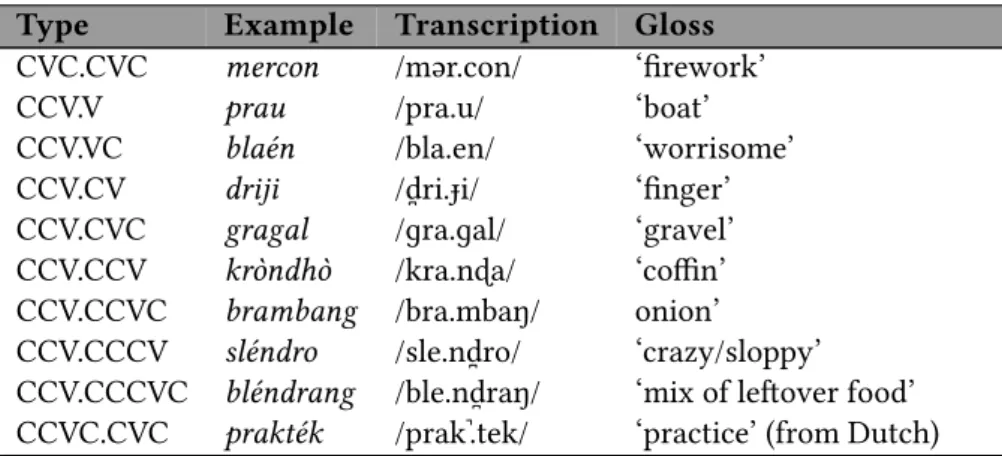
Consonant Clusters
The next type of consonant cluster, a nasal followed by an obstruent, mostly occurs in root-medial position (69). A fifth type of consonant cluster, a nasal followed by a liquid, can occur in both root-initial and root-medial positions (72)-(73).
Sequences of Consonants
A three-consonant cluster with a fricative as the first consonant of the sequence also occurs in the root-initial position of a number of loanwords (77). In the next chapter, where the rules of reversal in Walikan are discussed, we will look again at which authenticated groups in Malangan Javanese are allowed in a reversed language.
Sequences of Vowels
Nasal Prefix (N-̠)
In Table 3.14, the prefix N- is realized as a velar nasal before root-initial consonants, which are either liquid /r, l/ or approximant /j/. When a nasal prefix is attached to a root with two consonants in initial position, they form clusters of three consonants in word-initial position, as shown in Table 3.16.
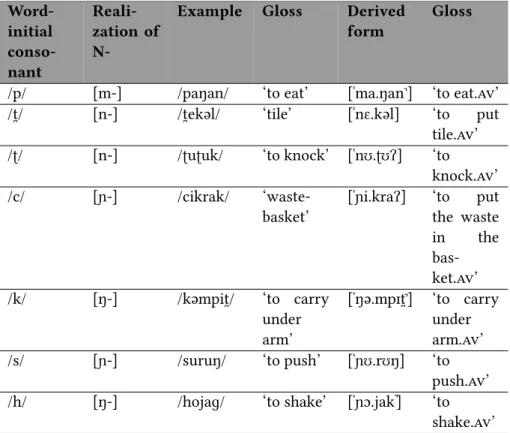
Reduplication
In summary, the nasal prefix in Malangan Javanese forms multiple words with a nasal consonant in initial position. The reduplicated form is placed before the original form (85). 85) Reduplication with different vowels Verb base tuku 'to buy'.
Stress
The last vowel in the root base is replaced with /a/ to create the duplicated form. In Walikan, reduplication is used in the same way and to express the same kind of meaning (see §4.4) as in Malangan Javanese.
Malangan Indonesian
Segment Inventory
As with Malanga Javanese, the high vowels /i/ and /u/ each have a slightly lower allophone [ɪ] and [ʊ] respectively. The allophones are conditioned by the syllable structure of the root: they appear in closed syllables and in open syllables before a closed syllable with a high mid vowel, a mid vowel, or a low vowel.
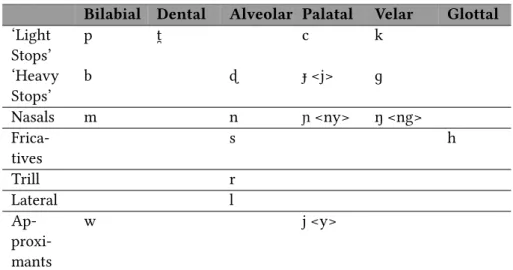
Description of the Consonants
- The Stops
- The Nasals
- The Fricatives
- The Trill and the Lateral
- The Approximants
Because of the voiceless stops and the tendency to realize /k/ as a glottal stop, Malangan Indonesian speakers are considered medhòk, a Javanese word meaning 'provincial, heavily accented' (see also Adisamito-Smith (2004: 29)) . The nasals /m, n, ɲ, ŋ/ in Malangaan Indonesian can occur in word-initial and word-medial position, similar to the nasals in Malangaan Javanese.
Description of the Vowels
- The High Vowels
- The High-Mid Vowels
- The Mid Vowel
- The Low Vowel
The front unrounded high-mid vowel /e/ is realized as [e] in an open syllable, as shown in (104). The mid-high rounded vowel /o/ is realized as the mid-high rounded vowel [o] in an open syllable (105).
Phonotactics
- Consonants
- Vowels
Similar to the situation in Malangaan Javanese, the high vowels /i, u/ and the high-mid vowels /e, o/ in Malangan Indonesian each have an allophone. Unlike the situation in Malangaan Javanese, the low vowel /a/ in Malangaan Indonesian does not have another allophonic realization.
Syllable Structure
The combination of complex onsets in Indonesian Malangan is very similar to that of Javanese Malangan. Note that Javanese Malangan has a cluster consisting of a glide followed by a liquid, which is not found in Indonesian Malangan.
Root Structure
However, the number of possible disyllabic root structure in Indonesian Malangan is less than Javanese Malangan. The following list may not be complete due to the limited corpus of Malangan Indonesian in this study and the number of loanwords incorporated into Malangan Indonesian.
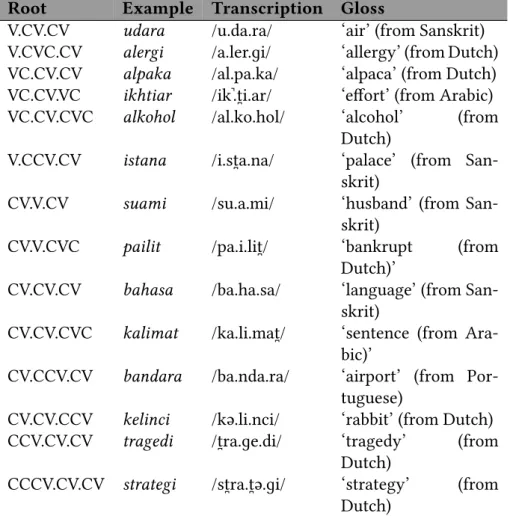
Consonant Clusters
The second type of consonant cluster in Malangan Indonesian is an obstruent followed by a glide, shown in (116) and (117). Unlike in Malangan Javanese, this cluster in Malangan Indonesian can only occur in root-medial position (121).
Sequences of Consonants
In the next chapter, where the inversion rules in Walikan are discussed, we will revisit which attested clusters in Malangan Indonesian are allowed in the reversed language.
Sequences of Vowels
Reduplication
Subsequently, Malangan Indonesian also shows a form of gemination in which the re-duplicated part of a verb base represents a different vowel from the root base (see §3.2.11), although it is not as common in my corpus as it is in Malangan Javanese. The duplicated form is placed in front of the original form Reduplication with different vowels Verbal basic balik ‘reverse’.
Stress
Conclusions
The glottal stop [ʔ] appears in both Malangan Javanese and Malangan Indonesian as the realization of /k/ in root-final and word-final position. The word medial homoorganic consonant clusters in Malangan Javanese and Indonesian are not separated by syllable boundaries.
Overview of Reversal Rules in Walikan
The most productive type of reversal in my corpus of Walikan is Total Segment Reversal (95%). The other 5% (36 out of 725 tokens) deviate from the Total Segment Reversal rule and fall under the Transposition, Sequence Exchange and Permutation reversal types.

Total Segment Reversal
Modifications in Total Segment Reversal
Segment Addition allows speakers to add a segment to a word that has undergone Total Segment Reversal. The second type, Segment Deletion, allows speakers to delete one or more segments of a word that has undergone Total Segment Reversal.
The Role of Phonology and Phonotactics
- Neutralization of Final Consonants . 148
- Palatal Stops and Bilabial Approxi-
- Consonant Sequences and Clusters . 153
- Vowel Alternation
The words in (52) show that the middle vowel /ə/ in word-final position after inversion is realized as [ɛ], as in the inversion of wordsenom. In òbit [ˈʔɔ.b̊i̤t̪̚], the underlying phoneme /a/ in the penultimate open syllable should have been realized as [a] instead of [ɔ].

Loanwords
Speakers pronounce slow as [sə.ˈlow] 'slow', word-initial consonant clusters are avoided by inserting a hyphen. Prenasalization in the initial position of the uninverted word is no longer present in the inverted form.
Affixation and Reduplication
In (68) the nasal prefix of the root word and that of the Walikan form are the same, as in [ˈŋɔ.pi] and [ˈŋi.pɔʔ] 'to drink coffee.av'. Evidence that Walikan operates within the root domain can also be noted below.
Other Forms of Reversal
The second type of sequence-based change inverts the final VC sequence of a word and transposes it to the initial position (78). Further, Permutation refers to the process in which segments are rearranged in a non-systematic manner.
Variation of Rules
Conclusions
Gender
Fluency
Types of Interaction
Places of Interaction
Word forms
Age
Fluency
Types of Interaction
Places of Interaction
Word Forms
Word Choices
Conclusions
Language Ecology in Indonesia and Java
Walikan in Spoken Media
Television and Radio
Songs
YouTube Videos
Walikan in Written Media
Dictionaries
Newspapers
Social Media
The City’s Linguistic Landscape
T-Shirts and Merchandise
Motivations to Promote Walikan
Walikan Forms in Spoken and Written Media
Conclusions
Reversal and Phonology
Phonology of Malangan Javanese and Indonesian 251
Sociolinguistic Variability in Walikan
Future of Walikan
Directions for Future Research
